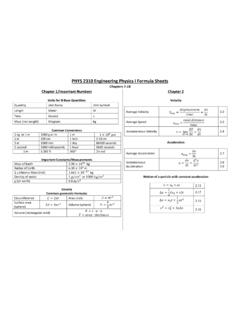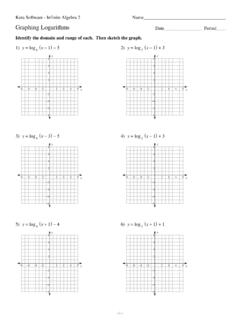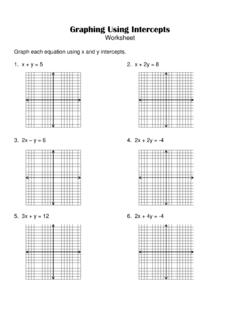Transcription of Asymptotes, Holes, and Graphing Rational Functions
1 Revised 7/13/12 Asymptotes, Holes, and Graphing Rational Functions Holes It is possible to have holes in the graph of a Rational function. Before putting the Rational function into lowest terms, factor the numerator and denominator. If there is the same factor in the numerator and denominator, there is a hole. Set this factor equal to zero and solve. The solution is the x-value of the hole. Now simplify the Rational function (cross out the factor that is the numerator and denominator). Put the x-value of the hole into the simplified Rational function. This will give the y-value of the hole. Asymptotes When finding asymptotes always write the Rational function in lowest terms. It is best not to have the function in factored form Vertical Asymptotes Set the denominator equation to zero and solve for x. The equation for a vertical asymptote is written x=k, where k is the solution from setting the denominator to zero.
2 *If you substitute k into the Rational function and it equals zero in the numerator and denominator, then you have not written the function in lowest terms Horizontal Asymptotes There are 3 cases Let N be the degree of the numerator, and D be the degree of the denominator 1) If N<D, then y=0 is the horizontal asymptotes 2) If N=D, then y=a/b (where a is the leading coefficient of the numerator and b is the leading coefficient of the denominator) is the horizontal asymptote. 3) If N>D, then there is no horizontal asymptote. If N>D by only one, then there is not a horizontal asymptote but there is a slant asymptote. Slant (aka oblique) Asymptote If the degree of the numerator is 1 more than the degree of the denominator, then there is a slant asymptote. To find the asymptote, divide the numerator by the denominator. The quotient is the equation for the slant asymptote.
3 Just ignore the remainder. Important Note: A Rational function will either have a horizontal or slant asymptote but not both. Graphing a Rational Function 1) Find any holes. Plot the holes as open circles. Revised 7/13/12 2) Find the vertical asymptotes and graph them as a dotted line. 3) Find any horizontal or slant asymptotes and graph it as a dotted line. 4) Find the y-intercept (if there is one) by setting x=0 (in both numerator and denominator) and solving. Plot the y-intercept. 5) Find the x-intercepts by setting the numerator equal to zero and solving for x. Plot any x-intercepts. 6) Determine if the graph will intersect its horizontal or slant asymptote. a. If there is a horizontal asymptote, say y=p, then set the Rational function equal to p and solve for x. If x is a real number, then the line crosses the horizontal asymptote at (x,p).
4 Plot this point. b. If there is a slant asymptote, y=mx+b, then set the Rational function equal to mx+b and solve for x. If x is a real number, then the line crosses the slant asymptote. Substitute this number into y=mx+b and solve for y. This will give us the point where the Rational function crosses the slant asymptote. Plot this point. 7) Choose an x value in each section created by the asymptotes, substitute the x value into the Rational function to get the y-value. Plot these points 8) Complete the sketch. Example Graph xxxxxxf44)(2323 1) We can factor the numerator and denominator we get )44()()(22 xxxxxxxf where x is a factor in the numerator and denominator. Setting this factor equal to zero we get x=0. We now cross out the common factor, and substitute 0 in for x we get y=0. There is a hole at (0,0) Our equation in lowest terms is 44)(22 xxxxxf 2) To find vertical asymptotes, we set the denominator equal to zero and solve.
5 When we do so, we get the asymptote of x=2 Revised 7/13/12 3) Since the degrees of the numerator and the denominator are the same, we take the coefficients and divide them. When we do, we get y=1/1=1 4) When we look for y-intercepts we get (0, 0). However, this is also a hole, so there is not a y-intercept. 5) When we look for x-intercepts we get (0,0) and (-1,0). Again (0,0) is a hole so it is not an x-intercept. We plot just (-1,0). 6) To determine if the curve crosses the horizontal asymptote (y=1), we set 44122 xxxx, and we get x=4/5 or .8. So the curve crosses at (.8,1) Revised 7/13/12 7) We select the x-values of -2, ,.5 , 4,5. Substituting these values into the function we get (-2, .13), ( , ), (.5,.33), (4,5), and (5, ) 8) We can now complete the sketch by connecting the dots, remember the graph of the Rational function will not cross any vertical asymptotes, it will just get really close to the asymptote.
6












